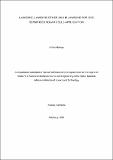| dc.contributor.author | Makoye, Amosi | |
| dc.date.accessioned | 2020-10-07T07:15:12Z | |
| dc.date.available | 2020-10-07T07:15:12Z | |
| dc.date.issued | 2020-02 | |
| dc.identifier.uri | https://doi.org/10.58694/20.500.12479/960 | |
| dc.description | A Dissertation Submitted in Partial Fulfillment of the Requirements for the Degree of
Master’s of Science in Materials Science and Engineering of the Nelson Mandela
African Institution of Science and Technology | en_US |
| dc.description.abstract | Dye-sensitized solar cells (DSSCs) had turned up as a novel class of low-cost solar cells that
can be fabricated easily compared to silicon solar cells. The DSSCs based on natural sensitizers
are able to generate clean energy at low production cost. The modification of natural dyes
facilitates the broadening of the light absorption range and improving overall DSSCs
performance. In this work structural and optoelectronic properties of lawsone (L), lawsone
ether (LE) and bilawsone (BL) were studied theoretically using the density functional theory
(DFT) and time-dependent density functional theory methods with hybrid functional B3LYP5
and 6-311G(2d,p) basis set. The electronic spectra of the dyes molecules in a vacuum and
solvents (dimethyl sulfoxide (DMSO) and dichloromethane (CH2Cl2)) were computed. The
maximum wavelengths were found at 355-408 nm for LE and 350-448 nm for BL that indicated
bands shift to visible range compared to L, 340 nm. The UV-Vis spectra of bilawsone and
lawsone in dimethyl sulfoxide solution were measured experimentally. For the BL, a broad and
intensive band was observed in a visible region at ~450 nm that apparently would favour
sensitizing ability of the dye. The performance of DSSCs sensitized with lawsone and
bilawsone were tested in outdoor conditions and I-V curves were measured. The power
conversion efficiency of DSSCs sensitized with bilawsone was 1.7%, and 0.6% with lawsone.
The results of the experimental measurements were in accordance with the theoretical
prediction of the optoelectronic properties of the dyes. The optoelectronic properties of the LE
and BL showed them as more promising candidates for DSSCs applications compared to
individual lawsone dye. Therefore, the energy conversion efficiency of the cell using bilawsone
dye revealed the enhancement in the cell performance.
Keywords: Lawsone isomers, Lawsone ether, Bilawsone, Dye-sensitized solar cells, UVVis/vibrational spectra, DFT/TD-DFT, Power conversion efficiency. | en_US |
| dc.language.iso | en | en_US |
| dc.publisher | NM-AIST | en_US |
| dc.rights | Attribution-NonCommercial-ShareAlike 4.0 International | * |
| dc.rights.uri | http://creativecommons.org/licenses/by-nc-sa/4.0/ | * |
| dc.subject | Research Subject Categories::NATURAL SCIENCES | en_US |
| dc.title | Lawsone, lawsone ether and bilawsone for dyesensitized solar cells application | en_US |
| dc.type | Thesis | en_US |


